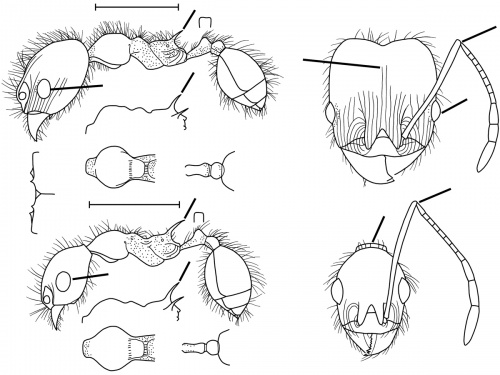Pheidole scimitara
| Pheidole scimitara | |
|---|---|
| Scientific classification | |
| Kingdom: | Animalia |
| Phylum: | Arthropoda |
| Class: | Insecta |
| Order: | Hymenoptera |
| Family: | Formicidae |
| Subfamily: | Myrmicinae |
| Tribe: | Attini |
| Genus: | Pheidole |
| Species: | P. scimitara |
| Binomial name | |
| Pheidole scimitara Wilson, 2003 | |
Nothing is known about the biology of scimitara.
Identification
See the description in the nomenclature section.
Keys including this Species
Distribution
Only known from the type locality.
Latitudinal Distribution Pattern
Latitudinal Range: -0.859° to -11.98293°.
| North Temperate |
North Subtropical |
Tropical | South Subtropical |
South Temperate |
- Source: AntMaps
Distribution based on Regional Taxon Lists
Neotropical Region: Brazil, Peru (type locality).
Distribution based on AntMaps
Distribution based on AntWeb specimens
Check data from AntWeb
Countries Occupied
| Number of countries occupied by this species based on AntWiki Regional Taxon Lists. In general, fewer countries occupied indicates a narrower range, while more countries indicates a more widespread species. |

|
Estimated Abundance
| Relative abundance based on number of AntMaps records per species (this species within the purple bar). Fewer records (to the left) indicates a less abundant/encountered species while more records (to the right) indicates more abundant/encountered species. |

|
Biology
Castes
Nomenclature
The following information is derived from Barry Bolton's Online Catalogue of the Ants of the World.
- scimitara. Pheidole scimitara Wilson, 2003: 228, figs. (s.w.) PERU.
Unless otherwise noted the text for the remainder of this section is reported from the publication that includes the original description.
Description
A very distinctive member of the diligens group, somewhat similar to Pheidole calimana, Pheidole cataractae, Pheidole demeter, Pheidole machetula, Pheidole sicaria and Pheidole tenuis, distinguished in both major and minor by the very long propodeal spines and extremely large eyes. Also, the antennal scape of the major exceeds the occipital corner by more than its own maximum width, and the minor has a narrowed occiput with nuchal collar.
MEASUREMENTS (mm) Holotype major: HW 1.00, HL 1.10, SL 1.00, EL 0.24, PW 0.54. Paratype minor: HW 0.54, HL 0.74, SL 0.98, EL 0.22, PW 0.40.
COLOR Major: head and mandibles medium to dark reddish brown; rest of body and appendages light yellowish brown
Minor: head and gaster light yellowish brown; mesosoma, waist, and appendages yellow.
Figure. Upper: holotype, major. Lower: paratype, minor. Scale bars = 1 mm.
Type Material
PERU: Estácion Biologica de Cocha Cashu, Madre de Dios, 400 m, col. Diane W. Davidson.Museum of Comparative Zoology
Etymology
Pers scimitara, a curved sword, referring to the propodeal spines.
References
- Wilson, E. O. 2003. Pheidole in the New World: A dominant, hyperdiverse ant genus. Harvard University Press, Cambridge, MA. (page 228, fig. major, minor described)
- Albuquerque, E., Prado, L., Andrade-Silva, J., Siqueira, E., Sampaio, K., Alves, D., Brandão, C., Andrade, P., Feitosa, R., Koch, E., Delabie, J., Fernandes, I., Baccaro, F., Souza, J., Almeida, R., Silva, R. 2021. Ants of the State of Pará, Brazil: a historical and comprehensive dataset of a key biodiversity hotspot in the Amazon Basin. Zootaxa 5001, 1–83 (doi:10.11646/zootaxa.5001.1.1).
References based on Global Ant Biodiversity Informatics
- Fernández, F. and S. Sendoya. 2004. Lista de las hormigas neotropicales. Biota Colombiana Volume 5, Number 1.
